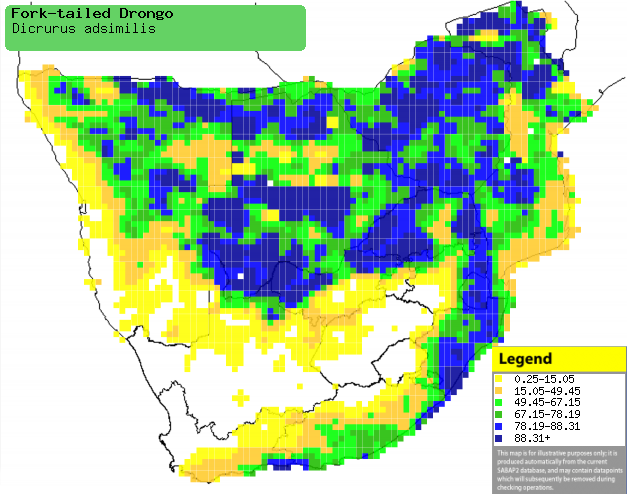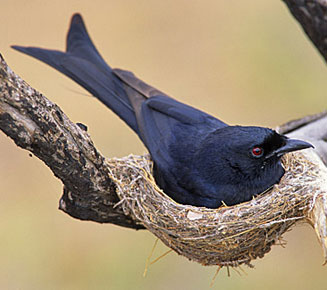Dicrurus adsimilis (Fork-tailed drongo)
Mikstertbyvanger [Afrikaans]; Intengu
[Xhosa]; iNtengu [Zulu]; Ntene [Kwangali]; Theko [North Sotho]; Nhengu, Nhengure
(both names also applied to Southern black flycatcher) [Shona]; Intsengu
[Swazi]; Mantengu [Tsonga]; Kuamosi [Tswana]; Fluweeldrongo [Dutch]; Drongo
brillant [French]; Trauerdrongo, Gabelschwanzdrongo [German];
Drongo-de-cauda-forcada [Portuguese]
Life
> Eukaryotes >
Opisthokonta
> Metazoa (animals) >
Bilateria >
Deuterostomia > Chordata >
Craniata > Vertebrata (vertebrates) > Gnathostomata (jawed
vertebrates) > Teleostomi (teleost fish) > Osteichthyes (bony fish) > Class:
Sarcopterygii (lobe-finned
fish) > Stegocephalia (terrestrial
vertebrates) > Tetrapoda
(four-legged vertebrates) > Reptiliomorpha > Amniota >
Reptilia (reptiles) >
Romeriida > Diapsida > Archosauromorpha > Archosauria >
Dinosauria
(dinosaurs) > Saurischia > Theropoda (bipedal predatory dinosaurs) >
Coelurosauria > Maniraptora > Aves
(birds) > Order: Passeriformes
> Family: Dicruridae
Distribution and habitat
Occurs across sub-Saharan Africa, absent only from
extremely arid areas. In southern Africa it is common and widespread, with
massive populations in Botswana, Zimbabwe, Mozambique, Namibia and South Africa,
absent from some grassland and arid habitats. It generally occurs in woodland,
such as savanna and riverine woodland, but is also common in alien tree
plantations, forest edges, grassland with scattered trees, farmland, gardens and
parks.
|
 |
|
Distribution of Fork-tailed drongo in southern Africa,
based on statistical smoothing of the records from first SA Bird Atlas
Project (©
Animal Demography unit, University of
Cape Town; smoothing by Birgit Erni and Francesca Little). Colours range
from dark blue (most common) through to yellow (least common).
See here for the latest distribution
from the SABAP2. |
Brood parasites
It has been recorded as host of the
Jacobin cuckoo and
African cuckoo.
Food
Highly adaptable, it eats a variety of animal prey,
especially insects but also other birds and fish. It often hawks insects from a
perch, catching them in flight or on the ground, often targeting insects flying
around electric lights. It is a kleptoparasite, regurlarly stealing food from
other birds (often within a mixed-species foraging flock) and mammals. A good
example is the Suricate (Suricata suricatta): In the Kalahari Desert,
drongos sometimes perch above a few foraging Suricates, waiting till one of them
finds food, at which point it mimicks their alarm call, snatching up their prey
in the ensuing confusion. The followin food items have been recorded in its
diet:
- Animals
- Arthropods
- Apis mellifera (Honey bee), often caught near their hive.
-
Coleoptera (beetle larvae)
- Paper wasps (Polistinae)
- caterpillars of Imbrasia belina (Mopane emperor moth)
- ticks, often taken from cattle.
-
termites
- Vertebrates
- small lizards
- fish
- Birds
- nestlings
- adults
- eggs and chicks
- Plants
Breeding
- The nest (see image below) is a thinly-walled cup made of twigs, leaf petioles and tendrils,
strongly bound together with spider web strands. It is usually placed like a
hammock between the branches of a tree fork, roughly 4-6 metres above
ground.
 |
|
|
Fork-tailed drongo in its nest, Sericea
farm, South Africa. [photo Warwick Tarboton ©] |
|
- Egg-laying season is from August-January, peaking from
September-October.
- It lays 2-5 eggs, which are incubated by both sexes for about 15-18
days.
- The chick are fed and brooded by both parents, leaving the nest after
about 16-22 days.
Threats
Not threatened.
References
-
Hockey PAR, Dean WRJ and Ryan PG 2005. Roberts
- Birds of southern Africa, VIIth ed. The Trustees of the John Voelcker
Bird Book Fund, Cape Town.
|
